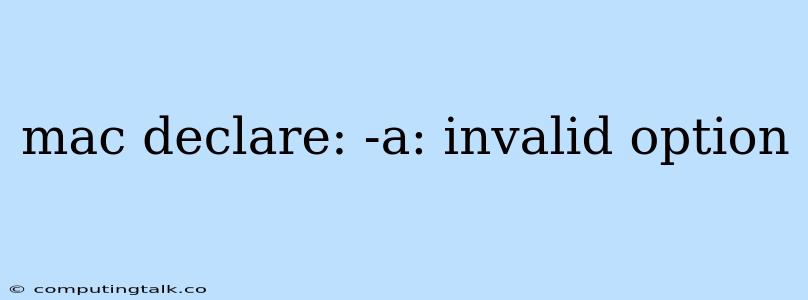The error message "mac declare: -a: invalid option" typically arises when you attempt to use the -a flag with the declare command in a macOS environment. This error indicates that the -a flag is not a valid option for the declare command in macOS.
Let's delve into the details of this error, understand its root cause, and explore potential solutions.
Understanding the declare Command and its Flags
The declare command is a powerful tool in shell scripting, allowing you to declare and manipulate variables and their attributes. In macOS, the declare command is a built-in function of the Bash shell. The declare command has various options (also known as flags) that modify its behavior.
The -a Flag: Not Supported in macOS
The -a flag is typically used with the declare command in some Unix-like operating systems, including Linux, to declare an array variable. However, macOS's version of the declare command does not recognize the -a flag. This is because the declare command on macOS operates differently from its Linux counterpart.
Common Scenarios Where the Error Occurs
The mac declare: -a: invalid option error commonly appears when you attempt to:
- Declare an array variable: When you try to create an array variable using
declare -aas you might do in a Linux environment, you will encounter this error in macOS. - Run a script written for a different OS: If you are using a shell script originally written for a Linux system and it uses
declare -a, you will likely see this error on your macOS system.
Solutions and Alternatives
Method 1: Using declare -A
While declare -a is not supported in macOS, you can use the declare -A option to achieve the same functionality of declaring an array variable. The -A flag in macOS's declare command explicitly defines an associative array (a dictionary-like structure). This is the recommended alternative for declaring arrays on macOS.
Example:
declare -A myArray
myArray[key1]=value1
myArray[key2]=value2
echo ${myArray[key1]}
Method 2: Declaring Arrays Directly
If you need to declare a simple, indexed array, you can use the traditional method of assigning values within square brackets.
Example:
myArray=(value1 value2 value3)
echo ${myArray[0]}
Method 3: Adjusting Scripts for Compatibility
If you are using a script that originated in a Linux environment, review the script to replace occurrences of declare -a with either declare -A or the direct array assignment method.
Important Considerations:
- Script Portability: Be mindful of the potential for script portability issues when using
declare -Ainstead ofdeclare -aif your script might need to run on both macOS and Linux systems. - Array Types: The
declare -Aoption in macOS creates an associative array, which is similar to a dictionary. If you need a simple indexed array, consider the direct assignment method.
Conclusion:
The error "mac declare: -a: invalid option" is a consequence of the macOS declare command's behavior, which differs from its Linux counterpart. By utilizing the alternative declare -A flag or the direct array declaration approach, you can create and manage array variables effectively on macOS systems.
